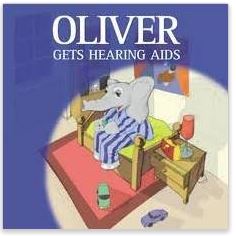Student Materials for Learning About Hearing Loss & Hearing Aids
There are a large number of publications that provide information to assist students in learning about the impact of hearing loss, hearing aids and how to care for them. The following are a few readily available resources.
Learning About the Ear
Want to do a fun activity with your elementary-age students to teach them the parts of the ear and how it works? Try the EDIBLE EAR! Use food items for fun and learning. See the Edible Ear for a list of materials and a visual of the finished ‘ear.’
Evolution of the Hearing Aid
An engaging infographic that will inform students of how hearing aids have developed over time. An interesting way of taking newly learned information about the parts of the hearing aid and how they function and apply this knowledge to hearing aids across time.
I’m the Boss of My Hearing Loss
A great message and fun illustrations for elementary students. The main character shows off his hearing aids to his peers. It describes hearing aids, their parts, FM systems and why they help and finally how to troubleshoot amplification issues. Includes communication ‘tips’ for peers and self-advocacy tips for kids with hearing loss. It ends with the image of an audiogram showing the range for quiet and loud. Overall, this one little book covers most of what kids should know and protrays a healthy self-image and empowering message. Book can be purchased individually or along with a CD.
Regardless of whether one’s child has a hearing disability or not, this is a wonderful and absolutely adorable book for children of all ages. The steps that Oliver must undertake to finally hear again is so true in real-time and aptly written for younger children to understand. First graders are able to read nearly all this book without help and ask their questions throughout it because they are naturally curious.
![]() By a mom: “This came with my son’s hearing aids (age 4). I asked his preschool and kindergarten teacher to read it to the class. In first grade, my son really wanted his teacher to read it to the class as it appears the students started noticing his hearing aids much more than before. This explains why Oliver needs hearing aids and it goes through the process of his getting hearing aids and how they help him at home and at school. It is simple language and it does a great job.” Made available by Phonak.
By a mom: “This came with my son’s hearing aids (age 4). I asked his preschool and kindergarten teacher to read it to the class. In first grade, my son really wanted his teacher to read it to the class as it appears the students started noticing his hearing aids much more than before. This explains why Oliver needs hearing aids and it goes through the process of his getting hearing aids and how they help him at home and at school. It is simple language and it does a great job.” Made available by Phonak.
Literacy Booster for Oliver Gets Hearing Aids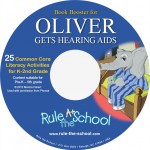
This much loved book, published in 2001, was written by Maureen Cassidy Riski, Nikolas Klakow and illustrated by Polygone, Nicolas Babey. The Phonak hearing aid company has generously provided Oliver Gets Hearing Aids free for download for you to have on your iPad/computer or for you to print out on a color printer. You can also purchase the book through Amazon. Oliver Gets Hearing Aids Literacy Booster digital files $7.00 
Having Hearing Aids
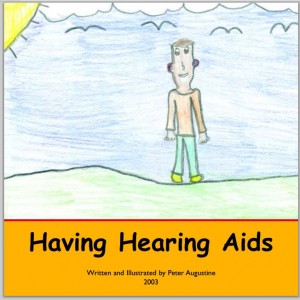
![]() Written by 9 year old Peter Augustine, in 2003, this colorful booklet describes Peter’s experience as a young boy with hearing loss, the hearing test procedure and what it’s like to wear and rely on hearing aids. All text and illustrations are by Peter. Made available by Oticon.
Written by 9 year old Peter Augustine, in 2003, this colorful booklet describes Peter’s experience as a young boy with hearing loss, the hearing test procedure and what it’s like to wear and rely on hearing aids. All text and illustrations are by Peter. Made available by Oticon.
The hearing aids described in this book are dated but this would act as a prompt with the student about how his hearing aids are different and better! Because it was written by an 8 year old, this book will appeal to young children and they can compare their experiences with what Peter went through and how he felt about it.
Developing Skills Related to Hearing Status
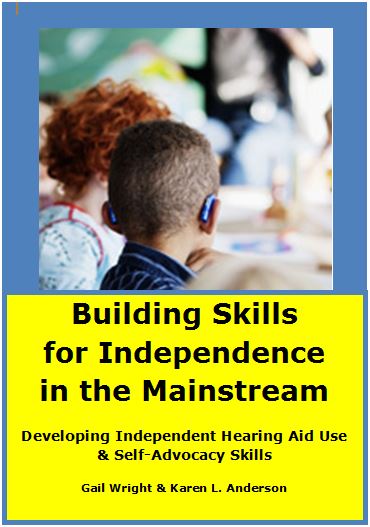 Audiology Self-Advocacy Checklist-ELEMENTARY SCHOOL (ASAC-ES)
Audiology Self-Advocacy Checklist-ELEMENTARY SCHOOL (ASAC-ES)
Audiology Self-Advocacy Checklist-MIDDLE SCHOOL (ASAC-ES)
Audiology Self-Advocacy Checklist-HIGH SCHOOL (ASAC-ES)
These checklists contains skills that students should develop during elementary, middle and high school related to their hearing status. To complete the checklist, enter the date the topic is introduced and then track performance using the progress levels (1, 2, or 3). If the skill has not yet been introduced (NI) the item is included but does not receive a score. If the skill is not applicable for a student, note NA and eliminate that item in the overall scoring. Specific skills that are being addressed may also be recorded as objectives on the student’s IEP. Skills should be re-evaluated at least annually. Follow the scoring directions at the bottom to obtain an overall performance level. A mastery level of 90-100% indicates the student’s audiology self-advocacy skills are functioning at the proficient level. If proficiency is not reached when the student transitions to middle school, work should continue on the deficient skills.
Hearing Aid Monitoring Checklist
The Central Institute for the Deaf offers free resources for those willing to enter their name and email. Download the Ling Sounds Check, Hearing Aid Checklist, CI Checklist, Bone Conduction Device Checklist, Ear Diagram and others.
This rebus-style checklist was designed for use by pre-readers or early readers (preschool – grade 2). 
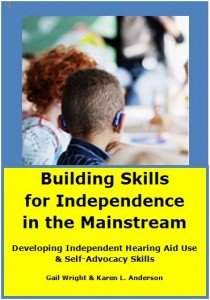 From the printed 128-page Building Skills for Independence in the Mainstream Guide + 50 downloadable files $46.00 + S/H
From the printed 128-page Building Skills for Independence in the Mainstream Guide + 50 downloadable files $46.00 + S/H 
Know of other readily available resources about hearing aids or hearing loss that are great to discuss with kids?
Contact info@successforkidswithhearingloss.com to share your idea.

